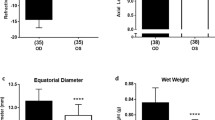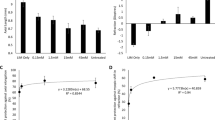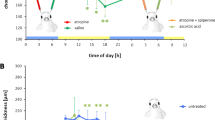Abstract
Purpose
While low-dose atropine eye drops are currently widely used to inhibit myopia development in children, the underlying mechanisms are poorly understood. Therefore, we studied possible retinal mechanisms and receptors that are potentially involved in myopia inhibition by atropine.
Methods
A total of 250 μg atropine were intravitreally injected into one eye of 19 chickens, while the fellow eyes received saline and served as controls. After 1 h, 1.5 h, 2 h, 3 h, and 4 h, eyes were prepared for vitreal dopamine (DA) measurements, using high-pressure liquid chromatography with electrochemical detection. Twenty-four animals were kept either in bright light (8500 lx) or standard light (500 lx) after atropine injection for 1.5 h before DA was measured. In 10 chickens, the α2A-adrenoreceptor (α2A-ADR) agonists brimonidine and clonidine were intravitreally injected into one eye, the fellow eye served as control, and vitreal DA content was measured after 1.5 h. In 6 chickens, immunohistochemical analyses were performed 1.5 h after atropine injection.
Results
Vitreal DA levels increased after a single intravitreal atropine injection, with a peak difference between both eyes after 1.97 h. DA was also enhanced in fellow eyes, suggesting a systemic action of intravitreally administered atropine. Bright light and atropine (which both inhibit myopia) had additive effects on DA release. Quantitative immunolabelling showed that atropine heavily stimulated retinal activity markers ZENK and c-Fos in cells of the inner nuclear layer. Since atropine was recently found to also bind to α2A-ADRs at doses where it can inhibit myopia, their retinal localization was studied. In amacrine cells, α2A-ADRs were colocalized with tyrosine hydroxylase (TH), glucagon, and nitric oxide synthase, peptides known to play a role in myopia development in chickens. Intravitreal atropine injection reduced the number of neurons that were double-labelled for TH and α2A-ADR. α2A-ADR agonists clonidine and brimonidine (which were also found by other authors to inhibit myopia) severely reduced vitreal DA content in both injected and fellow eyes, compared to eyes of untreated chicks.
Conclusions
Merging our results with published data, it can be concluded that both muscarinic and α2A-adrenergic receptors are expressed on dopaminergic neurons and both atropine and α2A-ADR antagonists stimulate DA release whereas α2A-ADR agonists strongly suppress its release. Stimulation of DA by atropine was enhanced by bright light. Results are in line with the hypothesis that inhibition of deprivation myopia is correlated with DA stimulation, as long as no toxicity is involved.










Similar content being viewed by others
References
Cohn H (1892) Lehrbuch der Hygiene des Auges. Urban & Schwarzenberg Wien Leipzig
McBrien NA, Moghaddam HO, Reeder AP (1993) Atropine reduces experimental myopia and eye enlargement via a nonaccommodative mechanism. Invest Ophthalmol Vis Sci 34:205–215
Carr BJ, Mihara K, Ramachandran R, Saifeddine M, Nathanson NM, Stell WK, Hollenberg D (2018) Myopia-inhibiting concentrations of muscarinic receptor antagonists block activation of alpha2a-adrenoceptors in vitro. Invest Ophthalmol Vis Sci 59:2778–2791
Diether S, Schaeffel F, Lambrou GN, Fritsch C, Trendelenburg AU (2007) Effects of intravitreally and intraperitoneally injected atropine on two types of experimental myopia in chicken. Exp Eye Res 84:266–274
Chia A, Lu QS, Tan D (2016) Five-year clinical trial on atropine for the treatment of myopia 2: myopia control with atropine 0.01% eye drops. Ophthalmol 123:391–399
Pineles SL, Kraker RT, VanderVeen DK, Hutchinson AK, Galvin JA, Wilson LB, Lambert SR (2017) Atropine for the prevention of myopia progression in children: a report by the American Academy of Ophthalmology. Ophthalmol 124:1857–1866
Kradjan WA, Smallridge R, Davis R, Verma P (1985) Atropine serum concentrations after multiple inhaled doses of atropine sulfate. Clin Pharmacol Ther 38:12–15
Fischer AJ, Miethke P, Morgan IG, Stell WK (1998) Cholinergic amacrine cells are not required for the progression and atropine-mediated suppression of form-deprivation myopia. Brain Res 794:48–60
McBrien NA, Arumugam B, Gentle A, Chow A, Sahebjada S (2011) The M4 muscarinic antagonist MT-3 inhibits myopia in chick: evidence for site of action. Ophthalmic Physiol Opt 31:529–523
Nickla DL, Yusupova Y, Totonelly K (2015) The muscarinic antagonist MT3 distinguishes between form deprivation- and negative lens-induced myopia in chicks. Curr Eye Res 40:962–967
Carr BJ, Stell WK (2016) Nitric oxide (NO) mediates the inhibition of form-deprivation myopia by atropine in chicks. Sci Rep 6:9
Diether S, Schaeffel F (1999) Long-term changes in retinal contrast sensitivity in chicks from frosted occluders and drugs: relations to myopia? Vis Res 39:2499–2510
Schwahn HN, Kaymak H, Schaeffel F (2000) Effects of atropine on refractive development, dopamine release, and slow retinal potentials in the chick. Vis Neurosci 17:165–176
Nickla DL, Zhu X, Wallman J (2013) Effects of muscarinic agents on chick choroids in intact eyes and eyecups: evidence for a muscarinic mechanism in choroidal thinning. Ophthalmic Physiol Opt 33:245–245
Zhang Z, Zhou Y, Xie Z, Chen T, Gu Y, Lu S, Wu Z (2016) The effect of topical atropine on the choroidal thickness of healthy children. Sci Rep 6:34936
Chiang ST, Phillips JR (2018) Effect of atropine eye drops on choroidal thinning induced by hyperopic retinal defocus. J Ophthalmol 14:8528315
Wallman J, Wildsoet C, Xu A, Gottlieb MD, Nickla DL, Marran L, Krebs W, Christensen AM (1995) Moving the retina: choroidal modulation of refractive state. Vis Res 35:37–50
Wallman J, Winawer J (2004) Homeostasis of eye growth and the question of myopia. Neuron 43:447–468
Read SA, Alonso-Caneiro D, Vincent SJ, Collins MJ (2015) Longitudinal changes in choroidal thickness and eye growth in childhood. Invest Ophthalmol Vis Sci 56:3103–3112
Nickla DL, Totonelly K, Dhillon (2010) Dopaminergic agonists that result in ocular growth inhibition also elicit transient increases in choroidal thickness in chicks. Exp Eye Res 91: 715–720
Schaeffel F, Howland HC (1991) Properties of the feedback loops controlling eye growth and refractive state in the chicken. Vis Res 31:717–734
Schaeffel F, Bartmann M, Hagel G, Zrenner E (1995) Studies on the role of the retinal dopamine/melatonin system in experimental refractive errors in chickens. Vis Res 35:1247–1264
Li XX, Schaeffel F, Kohler K, Zrenner E (1992) Dose-dependent effects of 6-hydroxy dopamine on deprivation myopia, electroretinograms, and dopaminergic amacrine cells in chickens. Vis Neurosci 9:483–492
Mathis U, Ziemssen F, Schaeffel F (2014) Effects of a human VEGF antibody (bevacizumab) on deprivation myopia and choroidal thickness in the chicken. Exp Eye Res 127:161–169
Megaw PL, Boelen MG, Morgan IG, Boelen MK (2006) Diurnal patterns of dopamine release in chicken retina. Neurochem Int 48:17–23
Carr BJ, Nguyen CT, Stell WK (2019) Alpha2 -adrenoceptor agonists inhibit form-deprivation myopia in the chick. Clin Exp Optom 102:418–425
Mathis U, Schaeffel F (2010) Transforming growth factor-beta in the chicken fundal layers: an immunohistochemical study. Exp Eye Res 90:780–790
Fischer AJ, Reh TA (2000) Identification of a proliferating marginal zone of retinal progenitors in postnatal chickens. Dev Biol 220:197–210
Bitzer M, Schaeffel F (2002) Defocus-induced changes in ZENK expression in the chicken retina. Invest Ophthalmol Vis Sci 43:246–252
Edqvist PH, Myers SM, Hallböök F (2006) Early identification of retinal subtypes in the developing, pre-laminated chick retina using the transcription factors Prox1, Lim1, Ap2alpha, Pax6, Isl1, Isl2, Lim3 and Chx10. Eur J Histochem 50:147–154
Fischer AJ, Stanke JJ, Aloisio G, Hoy H, Stell WK (2007) Heterogeneity of horizontal cells in the chicken retina. J Comp Neurol 500:1154–1171
Fischer AJ, Schmidt M, Omar G, Reh TA (2004) BMP4 and CNTF are neuroprotective and suppress damage-induced proliferation of Müller glia in the retina. Mol Cell Neurosci 27:531–542
Bitzer M, Kovacs B, Feldkaemper M, Schaeffel F (2006) Effects of muscarinic antagonists on ZENK expression in the chicken retina. Exp Eye Res 8:379–388
Harun-Or-Rashid M, Lindqvist N, Hallböök F (2014) Transactivation of EGF receptors in chicken Müller cells by α2A-adrenergic receptors stimulated by brimonidine. Invest Ophthalmol Vis Sci 55:3385–3394
Fischer AJ, Stell WK (1999) Nitric oxide synthase-containing cells in the retina, pigmented epithelium, choroid, and sclera of the chick eye. J Comp Neurol 405:1–14
Bitzer M, Schaeffel F (2004) Effects of quisqualic acid on retinal ZENK expression induced by imposed defocus in the chick eye. Optom Vis Sci 81:127–136
Ohngemach S, Hagel G, Schaeffel F (1997) Concentrations of biogenic amines in fundal layers in chickens with normal visual experience, deprivation, and after reserpine application. Vis Neurosci 14:493–505
Rohrer B, Iuvone PM, Stell WK (1995) Stimulation of dopaminergic amacrine cells by stroboscopic illumination or fibroblast growth factor (bFGF, FGF-2) injections: possible roles in prevention of form deprivation myopia in the chick. Brain Res 686:169–181
Luft WA, Iuvone PM, Stell WK (2004) Spatial, temporal, and intensive determinants of dopamine release in the chick retina. Vis Neurosci 21:627–635
Simon P, Feldkaemper M, Bitzer M, Ohngemach S, Schaeffel F (2004) Early transcriptional changes of retinal and choroidal TGFbeta-2, RALDH-2, and ZENK following imposed positive and negative defocus in chickens. Mol Vis 10:588–597
Araki CM, Hamassaki-Britto DE (1998) Motion-sensitive neurons in the chick retina: a study using Fos immunohistochemistry. Brain Res 794:333–337
Su YY, Watt CB (1987) Interaction between enkephalin and dopamine in the avian retina. Brain Res 423:63–70
Yamagata K, Goto K, Kuo CH, Kondo H, Miki N (1990) Visinin: a novel calcium binding protein expressed in retinal cone cells. Neuron 4:469–476
Bruhn SL, Cepko CL (1996) Development of the pattern of photoreceptors in the chick retina. Neurosci 16:1430–1439
Fischer AJ, Foster S, Scott MA, Sherwood P (2008) Transient expression of LIM-domain transcription factors is coincident with delayed maturation of photoreceptors in the chicken retina. J Comp Neurol 506:584–603
Ellis JH, Richards DE, Rogers JH (1991) Calretinin and calbindin in the retina of the developing chicken. Cell Tissue Res 264:197–208
Iuvone PM, Galli CL, Garrison-Gund CK, Neff NH (1978) Light stimulates tyrosine hydroxylase activity and dopamine synthesis in retinal amacrine neurons. Science 202:901–902
Stone RA, Lin T, Laties AM, Iuvone PM (1989) Retinal dopamine and form-deprivation myopia. Proc Natl Acad Sci 86:704–706
Fischer AJ, McGuire JJ, Schaeffel F, Stell WK (1999) Light- and focus-dependent expression of the transcription factor ZENK in the chick retina. Nat Neurosci 2:706–712
Vessey KA, Lencses KA, Rushforth DA, Hruby VJ, Stell WK (2005) Glucagon receptor agonists and antagonists affect the growth of the chick eye: a role for glucagonergic regulation of emmetropization? Invest Ophthalmol Vis Sci 46:3922–3931
Fischer AJ, McKinnon L, Nathanson NM, Stell WK (1998) Identification and localization of muscarinic acetylcholine receptors in the ocular tissues of the chick. J Comp Neurol 392:273–284
Stanke JJ, Lehman B, Fischer AJ (2008) Muscarinic signaling influences the patterning and phenotype of cholinergic amacrine cells in the developing chick retina. BMC Dev Biol 8:13
Fischer AJ, Seltner RL, Poon J, Stell WK (1998) Immunocytochemical characterization of quisqualic acid- and N-methyl-D-aspartate-induced excitotoxicity in the retina of chicks. J Comp Neurol 393:1–15
Iuvone PM, Rauch AL (1983) Alpha 2-adrenergic receptors influence tyrosine hydroxylase activity in retinal dopamine neurons. Life Sci 33:2455–2463
Zhou X, Pardue MT, Iuvone PM, Qu J (2017) Dopamine signaling and myopia development: what are the key challenges. Prog Retin Eye Res 61:60–71
Liu Y, Wang Y, Lv H, Jiang X, Zhang M, Li X (2017) α-Adrenergic agonist brimonidine control of experimentally induced myopia in Guinea pigs: a pilot study. Mol Vis 23:785 798. eCollection
Myhr KL, McReynolds JS (1996) Cholinergic modulation of dopamine release and horizontal cell coupling in mudpuppy retina. Vis Res 36:3933–3938
Hare WA, Owen WG (1995) Similar effects of carbachol and dopamine on neurons in the distal retina of the tiger salamander. Vis Neurosci 12:443–455
Luft WA, Ming Y, Stell WK (2003) Variable effects of previously untested muscarinic receptor antagonists on experimental myopia. Invest Ophthalmol Vis Sci 44:1330–1338
Dubocovich ML (1984) Alpha-2 adrenoceptors modulate [3H]dopamine release from rabbit retina. J Pharmacol Exp Ther 230:149–155
Ashby R, Ohlendorf A, Schaeffel F (2009) The effect of ambient illuminance on the development of deprivation myopia in chicks. Invest Ophthalmol Vis Sci 50:5348–5354
Ashby RS, Schaeffel F (2010) The effect of bright light on lens compensation in chicks. Invest Ophthalmol Vis Sci 51:5247–5253
Karouta C, Ashby RS (2014) Correlation between light levels and the development of deprivation myopia. Invest Ophthalmol Vis Sci 56:299–309
Lan W, Feldkaemper M, Schaeffel F (2013) Bright light induces choroidal thickening in chickens. Optom Vis Sci 90:1199–1206
Lan W, Feldkaemper M, Schaeffel F (2014) Intermittent episodes of bright light suppress myopia in the chicken more than continuous bright light. PLoS One 9:e110906
Lan W, Yang Z, Feldkaemper M, Schaeffel F (2016) Changes in dopamine and ZENK during suppression of myopia in chicks by intense illuminance. Exp Eye Res 145:118–124
Norton TT (2016) What do animal studies tell us about the mechanism of myopia-protection by light? Optom Vis Sci 93:1049–1051
Smith EL 3rd, Hung LF, Huang J (2012) Protective effects of high ambient lighting on the development of form-deprivation myopia in rhesus monkeys. Invest Ophthalmol Vis Sci 53:421–428
Smith EL 3rd, Hung LF, Arumugam B, Huang J (2013) Negative lens-induced myopia in infant monkeys: effects of high ambient lighting. Invest Ophthalmol Vis Sci 26:2959–2969
Rose KA, Morgan IG, Ip J, Kifley A, Huynh S, Smith W, Mitchell P (2008) Outdoor activity reduces the prevalence of myopia in children. Ophthalmology 115:1279–1285
Boelen MK, Boelen MG, Marshak DW (1998) Light-stimulated release of dopamine from the primate retina is blocked by 1-2-amino-4-phosphonobutyric acid (APB). Vis Neurosci 15(97):103
McCarthy CS, Megaw P, Devadas M, Morgan IG (2007) Dopaminergic agents affect the ability of brief periods of normal vision to prevent form-deprivation myopia. Exp Eye Res 84:100–107
Megaw P, Morgan I, Boelen MJ (2001) Vitreal dihydroxyphenylacetic acid (DOPAC) as an index of retinal dopamine release. Neurochem 76:1636–1644
Iuvone PM, Tigges M, Stone RA, Lambert S, Laties AM (1991) Effects of apomorphine, a dopamine receptor agonist, on ocular refraction and axial elongation in a primate model of myopia. Invest Ophthalmol Vis Sci 32:1674–1677
Chen S, Zhi Z, Ruan Q, Liu Q, Li F, Wan F, Reinach PS, Chen J, Qu J, Zhou X (2017) Bright light suppresses form-deprivation myopia development with activation of dopamine D1 receptor signaling in the ON pathway in retina. Invest Ophthalmol Vis Sci 58:2306–2316
Wulle I, Kirsch M, Wagner HJ (1990) Cyclic changes in dopamine and DOPAC content, and tyrosine hydroxylase activity in the retina of a cichlid fish. Brain Res 515:163–167
Kolbinger W, Weiler R (1993) Modulation of endogenous dopamine release in the turtle retina: effects of light, calcium, and neurotransmitters. Vis Neurosci 10:1035–1041
Boatright JH, Gordon JR, Iuvone PM (1994) Inhibition of endogenous dopamine release in amphibian retina by L-2-amino-4-phosphonobutyric acid (L-AP4) and trans-2 aminocyclopentane-1,3-dicarboxylate (ACPD). Brain Res 649:339–342
Morgan IG, Boelen MK (1996) A retinal dark-light switch: a review of the evidence. Vis Neurosci 13:399–409
Feldkaemper M, Schaeffel F (2013) An updated view on the role of dopamine in myopia. Exp Eye Res 114:106–119
Acknowledgments
We thank Sandra Bernhard-Kurz for excellent technical assistance.
Funding
This study was supported by the German Research Council (DFG Scha 518/15–1) to UM and FS, the European Union’s Horizon 2020 research and innovation programme under the Marie Sklodowska-Curie Research Training Network MyFun Grant MSCA-ITN-2015-675137 to FS and MF, and a stipend from the China Scholarship Council (No. 201606370188) to MW.
Author information
Authors and Affiliations
Corresponding author
Ethics declarations
Ute Mathis declares that she has no conflict of interest. Marita Feldkaemper declares that she has no conflict of interest. Min Wang declares that she has no conflict of interest. Frank Schaeffel declares that he has no conflict of interest. All applicable international, national, and/or institutional guidelines for the care and use of animals were followed. This article does not contain any studies with human participants performed by any of the authors.
Rights and permissions
About this article
Cite this article
Mathis, U., Feldkaemper, M., Wang, M. et al. Studies on retinal mechanisms possibly related to myopia inhibition by atropine in the chicken. Graefes Arch Clin Exp Ophthalmol 258, 319–333 (2020). https://doi.org/10.1007/s00417-019-04573-y
Received:
Revised:
Accepted:
Published:
Issue Date:
DOI: https://doi.org/10.1007/s00417-019-04573-y




